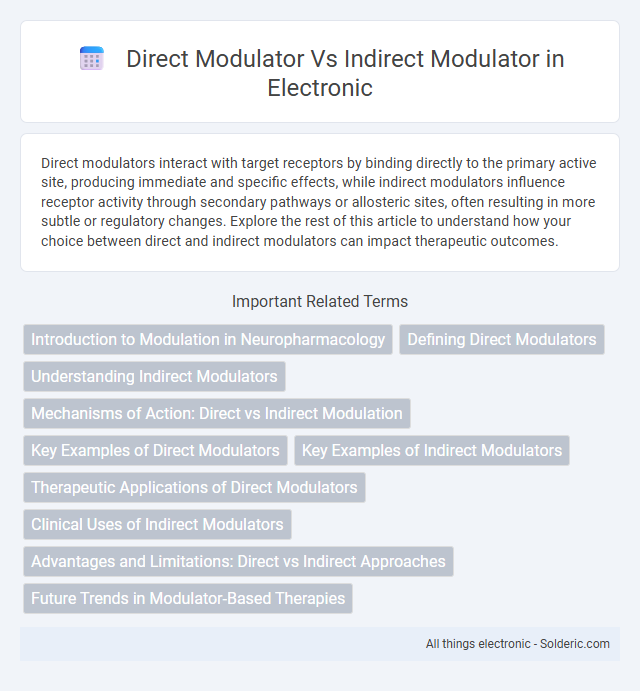Direct modulators interact with target receptors by binding directly to the primary active site, producing immediate and specific effects, while indirect modulators influence receptor activity through secondary pathways or allosteric sites, often resulting in more subtle or regulatory changes. Explore the rest of this article to understand how your choice between direct and indirect modulators can impact therapeutic outcomes.
Comparison Table
| Aspect | Direct Modulator | Indirect Modulator |
|---|---|---|
| Mechanism of Action | Binds directly to the receptor's active site | Modifies receptor activity via allosteric sites or secondary pathways |
| Binding Site | Orthosteric (primary) site | Allosteric (secondary) site or upstream signaling components |
| Effect on Receptor | Direct activation or inhibition | Enhances or diminishes response indirectly |
| Specificity | High specificity for receptor | Variable specificity, may affect multiple pathways |
| Examples | Agonists or antagonists like neurotransmitters | Allosteric modulators, enzyme inhibitors affecting receptor function |
| Therapeutic Use | Targeted receptor modulation | Fine-tuning receptor response with fewer side effects |
Introduction to Modulation in Neuropharmacology
Direct modulators in neuropharmacology bind directly to neurotransmitter receptors, inducing immediate conformational changes that enhance or inhibit receptor activity, critical for targeted therapeutic effects. Indirect modulators influence receptor function without directly binding to the active site, often by altering neurotransmitter release, reuptake, or degradation, thereby modulating synaptic transmission more diffusely. Understanding these mechanisms enables precise manipulation of neural pathways for treating neurological disorders, optimizing drug efficacy and reducing side effects.
Defining Direct Modulators
Direct modulators bind specifically to the active site of a receptor or enzyme, directly altering its activity by either enhancing or inhibiting its function. These modulators produce immediate effects by competing with endogenous ligands or substrates, enabling precise control over biological pathways. Your understanding of direct modulators is essential for applications in targeted drug design and therapeutic interventions.
Understanding Indirect Modulators
Indirect modulators influence receptor activity by binding to allosteric sites rather than the primary active site, resulting in a modified receptor response without directly activating the receptor. These modulators offer increased specificity and reduced desensitization compared to direct modulators, which bind directly to the active site and mimic endogenous ligands. Understanding indirect modulators is crucial for developing targeted therapies with fewer side effects in neurological and psychiatric disorders.
Mechanisms of Action: Direct vs Indirect Modulation
Direct modulators bind to the primary active site of a receptor or enzyme, producing an immediate response by directly altering its activity. Indirect modulators influence receptor function by interacting with secondary sites or pathways, such as regulating neurotransmitter release or receptor trafficking, resulting in a more subtle or delayed effect. Understanding these mechanisms helps optimize your therapeutic strategy by targeting the desired modulation pathway for specific clinical outcomes.
Key Examples of Direct Modulators
Key examples of direct modulators include benzodiazepines, barbiturates, and certain neurosteroids, which bind directly to neurotransmitter receptors such as GABA-A receptors to enhance or inhibit receptor activity. These modulators alter receptor function without requiring the presence of the endogenous ligand, providing fast and potent effects on synaptic transmission. Your understanding of direct modulators can be enhanced by studying their mechanisms in cases like benzodiazepines' role in anxiety and barbiturates' anesthetic properties.
Key Examples of Indirect Modulators
Key examples of indirect modulators include benzodiazepines, which enhance the effect of gamma-aminobutyric acid (GABA) at the GABA-A receptor without directly activating the receptor itself. Another important class is allosteric modulators of glutamate receptors, such as positive allosteric modulators of the NMDA receptor that subtly influence receptor function to improve synaptic plasticity. Understanding these indirect modulators can help you target receptor systems more selectively, potentially reducing side effects compared to direct modulators.
Therapeutic Applications of Direct Modulators
Direct modulators bind specifically to the active site of a receptor or enzyme, producing immediate and targeted therapeutic effects in conditions such as epilepsy, depression, and Parkinson's disease. These agents, including benzodiazepines and selective serotonin reuptake inhibitors (SSRIs), allow precise control over receptor activity, enhancing efficacy and reducing side effects in clinical use. Their direct mechanism enables rapid symptom relief and improved patient compliance in chronic and acute treatment scenarios.
Clinical Uses of Indirect Modulators
Indirect modulators are primarily used in clinical settings to enhance the effects of endogenous neurotransmitters by altering their release, reuptake, or degradation. These agents, such as selective serotonin reuptake inhibitors (SSRIs) for depression or acetylcholinesterase inhibitors for Alzheimer's disease, provide targeted therapeutic benefits by modulating neurotransmitter availability indirectly. Your treatment outcomes often improve with indirect modulators due to their ability to fine-tune neurotransmission without directly binding to receptor sites.
Advantages and Limitations: Direct vs Indirect Approaches
Direct modulators offer precise and rapid control by binding immediately to target receptors, enhancing efficacy in therapeutic interventions with reduced off-target effects. Indirect modulators influence signaling pathways by interacting with secondary sites or enzymes, providing broader system modulation but often with delayed response and higher risk of side effects. Your choice between direct and indirect modulators depends on the desired specificity, onset speed, and potential limitations related to target engagement and systemic impact.
Future Trends in Modulator-Based Therapies
Direct modulators target specific receptor sites for immediate therapeutic effects, while indirect modulators influence receptor activity through secondary pathways, offering broader systemic impacts. Future trends in modulator-based therapies emphasize precision medicine, utilizing advanced biomarker profiling and AI-driven drug design to enhance efficacy and reduce side effects. Your treatment options will increasingly benefit from personalized approaches that combine both direct and indirect modulation strategies for optimized clinical outcomes.
Direct modulator vs indirect modulator Infographic

 solderic.com
solderic.com